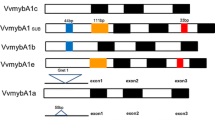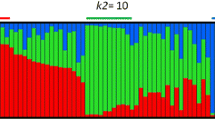Abstract
During the process of crop domestication and early selection, numerous changes occur in the genetic and physiological make-up of crop plants. In grapevine (Vitis vinifera) numerous changes have occurred as a result of human selection, including the emergence of hermaphroditism and greatly increased variation in berry color. This report examines the effect of human selection on variable skin color by examining the variation present in the gene VvmybA1, a transcriptional regulator of anthocyanin biosynthesis. In over 200 accessions of V. vinifera, the insertion of the retroelement Gret1 in the promoter region of VvmybA1 was in strong association with the white-fruited phenotype. This retroelement was inserted at the same location for each individual in which it was present. Additional polymorphisms in the VvmybA1 gene were also strongly associated with red or pink fruited accessions, including variation that was generated by the excision of Gret1 from the promoter of VvmybA1. Differences in nucleotide diversity were observed between the white and pigmented alleles of VvmybA1, suggesting that the white allele arose only once or a limited number of times. Rarely, association of Gret1 with the white fruited phenotype was not observed, suggesting that the white phenotype can also be obtained through mutation in additional genes. These results provide evidence that variation in one transcriptional regulator has generated an allelic series strongly associated with fruit color variation in cultivated grapevine. These findings provide information about the evolution of grapes since domestication and have direct implications for the regulation of fruit and wine quality of this important crop plant.


Similar content being viewed by others
References
Adam-Blondon A-F, Roux C, Claux D, Butterlin G, Merdinoglu D, This P (2004) Mapping 245 SSR markers on the Vitis vinifera genome: a tool for grape genetics. Theor Appl Genet 109:1017–1027
Barnaud A, Lacombe T, Doligez A (2005) Linkage disequilibrium in cultivated grapevine, Vitis vinifera L. Theor Appl Genet 112:708–716
Barritt BH, Einset J (1969) Inheritance of 3 Major Fruit Colors in Grapes. J Am Soc Hortic Sci 94:87
Bodeau JP, Walbot V (1992) Regulated transcription of the maize bronze-2 promoter in electroporated protoplasts requires the c1 and r gene-products. Mol Gen Genet 233:379–387
Brown GR, Gill GP, Kuntz RJ, Langley CH, Neale DB (2004) Nucleotide diversity and linkage disequilibrium in loblolly pine. PNAS 101:15255–15260
Coe EH, Neuffer MG, Hoisington DA (1988) The genetics of corn. In: Sprague GF, Dudley JW (eds) Corn and Corn Improvement, 3rd edn. ASA, CSSA, SSSA, Madison, pp 81–258
Doebley J, Stec A, Hubbard L (1997) The evolution of apical dominance in maize. Nature 386:485–488
Doligez A, et al. (2002) Genetic mapping of grapevine (Vitis vinifera L.) applied to the detection of QTLs for seedlessness and berry weight. Theor Appl Genet 105:780–795
Frary A, et al. (2000) fw2.2: A quantitative trait locus key to the evolution of tomato fruit size. Science 289:85–88
Galet P (2000a) Dictionnaire encyclopedique des cepages. Hachette
Galet P (2000b) General Viticulture. Oenoplurimedia, Chaintre, France
Goodman CD, Casati P, Walbot V (2004) A multidrug resistance-associated protein involved in anthocyanin transport in Zea mays. Plant Cell 16:1812–1826
Hamblin MT, et al. (2004) Comparative population genetics of the panicoid grasses: sequence polymorphism, linkage disequilibrium and selection in a diverse sample of Sorghum bicolor. Genetics 167:471–483
Hancock JF (1992) Plant evolution and origin of crop species, 1st edn. Prentice-Hall, Englewood Cliffs
Hanson MA, et al. (1996) Evolution of anthocyanin biosynthesis in maize kernels: the role of regulatory and enzymatic loci. Genetics 143:1395–1407
Hedrick UP, Anthony RD (1915) Inheritance of certain characters of grapes. New York State Agricultural College Technical Bulletin No. 45, pp 3–19
Hill WG, Roberston A (1968) Linkage disequilibrium in finite populations. Theor Appl Genet 38:226–231
Hocquigny S, Pelsey F, Dumas V, Kindt S, Heloir M-C, Merdinoglu D (2004) Diversification within grapevine cultivars goes through chimeric states. Genome 47:579–589
IPGRI, UPOV, OIV (1997) Descriptors for Grapevine (Vitis spp.). International union for the protection of new varieties of plants, Geneva, Switzerland/Office International de la Vigne et du Vin, Paris, France/International Plant Genetic Resources Institute, Rome
Kobayashi S, Goto-Yamamoto N, Hirochika H (2004) Retrotransposon-induced mutations in grape skin color. Science 304:982
Kobayashi S, Yamamoto NG, Hirochika H (2005) Association of VvmybA1 gene expression with anthocyanin production in grape (Vitis vinifera) skin - color mutants. J Jpn Soc Hortic Sci 74:196–203
Levadoux L (1956) Les populations sauvages et cultivees de Vitis vinifera L. Annales de l’amelioration des plantes 6:59–118
Lodhi MA, Daly MJ, Ye GN, Weeden NF, Reisch BI (1995) A molecular marker based linkage map of Vitis. Genome 38:786–794
Madero E, Boubals D, Truel P (1986) Transmission hereditaire des principaux caracters des cepages Cabernet Franc, Cabernet Sauvignon et Merlot (V. vinifera L.). Vigne Vini 13(Suppl. 12):209–219
Marrs KA, Alfenito MR, Lloyd AM, Walbot V (1995) A glutathione-s-transferase involved in vacuolar transfer encoded by the maize gene bronze-2. Nature 375:397–400
McGovern PE (2003) Ancient wine: the search for the origins of viticulture. Princeton University Press, Princeton
Olmo HP (1995) The origin and domestication of the Vinifera grape. In: McGovern PE (ed) The origins and ancient history of wine. Gordon and Breach, Amsterdam, pp 31–43
Olsen KM, Purugganan MD (2002) Molecular evidence on the origin and evolution of glutinous rice. Genetics 162:941–950
Palaisa KA, Morgante M, Tingey S, Rafalski A (2003a) Long-range patterns of diversity and linkage disequilibrium surrounding the maize Y1 gene are indicative of an asymmetric selective sweep. Proc Natl Acad Sci USA 101:9885–9890
Palaisa KA, Morgante M, Williams M, Rafalski A (2003b) Contrasting effects of selection on sequence diversity and linkage disequilibrium at two phytoene synthase loci. Plant Cell 15:1795–1806
Peng J, et al. (1999) ‘Green revolution’ genes encode mutant gibberellin response modulators. Nature 400:256–261
Pereira HS, Barao A, Delgado M, Morais-Cecilio L, Viegas W (2005) Genomic analysis of Grapevine Retrotransposon 1(Gret1) in Vitis vinifera. Theor Appl Genet 111:871–878
Pritchard JK, Stephens M, Donnelly P (2000) Inference of population structure using multilocus genotype data. Genetics 155:945–959
Purugganan MD, Boyles AL, Suddith JI (2000) Variation and selection at the CAULIFLOWER floral homeotic gene accompanying the evolution of domesticated Brassica oleracea. Genetics 155:855–862
Quattrocchio F, Wing JF, Leppen H, Mol J, Koes RE (1993) Regulatory genes controlling anthocyanin pigmentation are functionally conserved among plant species and have distinct sets of target genes. Plant Cell 5:1497–1512
Remington DL et al. (2001) Structure of linkage disequilibrium and phenotypic associations in the maize genome 1073/pnas.201394398. PNAS 98:11479–11484
Riaz S, Dangl GS, Edwards KJ, Meredith CP (2004) A microsatellite marker based framework linkage map of Vitis vinifera L. Theor Appl Genet 108:864–872
Rozas J, Rozas R (1999) DNAsp version 3: an integrated program for molecular population genetics and molecular evolution analysis. Bioinformatics 15:174–175
Snyder E, Harmon FN (1939) Grape progenies of self-pollinated vinifera varieties. Proc Am Soc Hortic Sci 37:625–626
Snyder E, Harmon FN (1952) Grape Breeding Summary 1923–1951. Proceedings of the American Society for Horticultural Science 60:243–246
Tenaillon MI, Sawkins MC, Long AD, Gaut RL, Doebley JF, Gaut BS (2001) Patterns of DNA sequence polymorphism along chromosome 1 of maize (Zea mays ssp mays L.). Proceedings of the National Academy of Sciences of the United States of America 98:9161–9166
Thornsberry JM, Goodman MM, Doebley J, Kresovich S, Nielsen D, Buckler IV ES (2001) Dwarf8 polymorphisms associate with variation in flowering time. Nature Genetics 28:286–289
Wang H, et al. (2005) The origin of the naked grains of maize. Nature 436:714–719
Wellington R (1939) The Ontario grape and its seedlings as parents. Proc Am Soc Hortic Sci 37:630–634
Winkel-Shirley B (2001) Flavonoid biosynthesis. A colorful model for genetics, biochemistry, cell biology, and biotechnology. Plant Physiol 126:485–493
Zhang F, Gonzalez A, Zhao MZ, Payne CT, Lloyd A (2003) A network of redundant bHLH proteins functions in all TTG1-dependent pathways of Arabidopsis. Development 130:4859–4869
Zohary D, Hopf M (2000) Domestication of plants in the old world, 3rd edn. Oxford University Press, London
Zohary D, Spiegel-Roy P (1975) Beginnings of fruit growing in the old world. Science 187:319–327
Acknowledgments
We are very grateful to Judith Kolkman for providing helpful suggestions to the manuscript. We would also like to thank Bernie Prins and Malli Aradhya of the USDA National Germplasm repository for providing grape DNA samples.
Author information
Authors and Affiliations
Corresponding author
Additional information
Communicated by S. J. Knapp.
Electronic supplementary material
Below is the link to the electronic supplementary material
Rights and permissions
About this article
Cite this article
This, P., Lacombe, T., Cadle-Davidson, M. et al. Wine grape (Vitis vinifera L.) color associates with allelic variation in the domestication gene VvmybA1 . Theor Appl Genet 114, 723–730 (2007). https://doi.org/10.1007/s00122-006-0472-2
Received:
Accepted:
Published:
Issue Date:
DOI: https://doi.org/10.1007/s00122-006-0472-2




